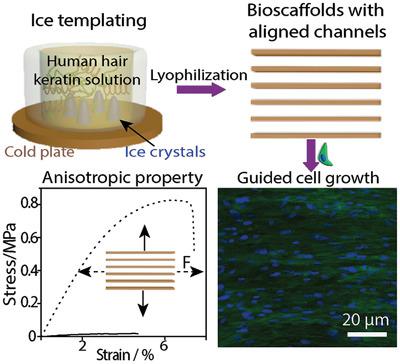当前位置:
X-MOL 学术
›
Macromol. Biosci.
›
论文详情
Our official English website, www.x-mol.net, welcomes your feedback! (Note: you will need to create a separate account there.)
Characterization of Anisotropic Human Hair Keratin Scaffolds Fabricated via Directed Ice Templating
Macromolecular Bioscience ( IF 4.6 ) Pub Date : 2020-11-04 , DOI: 10.1002/mabi.202000314 Zhitong Zhao 1 , Zi Kuang Moay 1 , Hui Ying Lai 1 , Bernice Huan Rong Goh 1 , Huei Min Chua 1 , Magdiel Inggrid Setyawati 1 , Kee Woei Ng 1, 2, 3, 4
Macromolecular Bioscience ( IF 4.6 ) Pub Date : 2020-11-04 , DOI: 10.1002/mabi.202000314 Zhitong Zhao 1 , Zi Kuang Moay 1 , Hui Ying Lai 1 , Bernice Huan Rong Goh 1 , Huei Min Chua 1 , Magdiel Inggrid Setyawati 1 , Kee Woei Ng 1, 2, 3, 4
Affiliation

|
Human hair keratin (HHK) is successfully exploited as raw materials for 3D scaffolds for soft tissue regeneration owing to its excellent biocompatibility and bioactivity. However, most HHK scaffolds are not able to achieve the anisotropic mechanical properties of soft tissues such as tendons and ligaments due to lack of tunable, well‐defined microstructures. In this study, directed ice templating method is used to fabricate anisotropic HHK scaffolds that are characterized by aligned pores (channels) in between keratin layers in the longitudinal plane. In contrast, pores in the transverse plane maintain a homogenous rounded morphology. Channel widths throughout the scaffolds range from ≈5 to ≈15 µm and are tunable by varying the freezing temperature. In comparison with HHK scaffolds with random, isotropic pore structures, the tensile strength of anisotropic HHK scaffolds is enhanced significantly by up to fourfolds (≈200 to ≈800 kPa) when the tensile load is applied in the direction parallel to the aligned pores. In vitro results demonstrate that the anisotropic HHK scaffolds are able to support human dermal fibroblast adhesion, spreading, and proliferation. The findings suggest that HHK scaffolds with well‐defined, aligned microstructure hold promise as templates for soft tissues regeneration by mimicking their anisotropic properties.
中文翻译:

通过定向冰模板制造的各向异性人发角蛋白支架的表征
人发角蛋白 (HHK) 因其优异的生物相容性和生物活性而被成功用作软组织再生 3D 支架的原材料。然而,由于缺乏可调节的、明确定义的微观结构,大多数 HHK 支架无法实现软组织(如肌腱和韧带)的各向异性机械性能。在这项研究中,定向冰模板法用于制造各向异性 HHK 支架,其特征在于纵向平面中角蛋白层之间的对齐孔(通道)。相反,横向平面中的孔保持均匀的圆形形态。整个支架的通道宽度范围从 ≈5 到 ≈15 µm,可通过改变冷冻温度进行调节。与具有随机、各向同性孔结构的 HHK 支架相比,当在平行于对齐孔的方向上施加拉伸载荷时,各向异性 HHK 支架的拉伸强度显着提高了四倍(≈200 到 ≈800 kPa)。体外结果表明,各向异性 HHK 支架能够支持人皮肤成纤维细胞的粘附、扩散和增殖。研究结果表明,具有明确、对齐的微观结构的 HHK 支架通过模仿其各向异性特性,有望成为软组织再生的模板。
更新日期:2020-11-04
中文翻译:

通过定向冰模板制造的各向异性人发角蛋白支架的表征
人发角蛋白 (HHK) 因其优异的生物相容性和生物活性而被成功用作软组织再生 3D 支架的原材料。然而,由于缺乏可调节的、明确定义的微观结构,大多数 HHK 支架无法实现软组织(如肌腱和韧带)的各向异性机械性能。在这项研究中,定向冰模板法用于制造各向异性 HHK 支架,其特征在于纵向平面中角蛋白层之间的对齐孔(通道)。相反,横向平面中的孔保持均匀的圆形形态。整个支架的通道宽度范围从 ≈5 到 ≈15 µm,可通过改变冷冻温度进行调节。与具有随机、各向同性孔结构的 HHK 支架相比,当在平行于对齐孔的方向上施加拉伸载荷时,各向异性 HHK 支架的拉伸强度显着提高了四倍(≈200 到 ≈800 kPa)。体外结果表明,各向异性 HHK 支架能够支持人皮肤成纤维细胞的粘附、扩散和增殖。研究结果表明,具有明确、对齐的微观结构的 HHK 支架通过模仿其各向异性特性,有望成为软组织再生的模板。



























 京公网安备 11010802027423号
京公网安备 11010802027423号